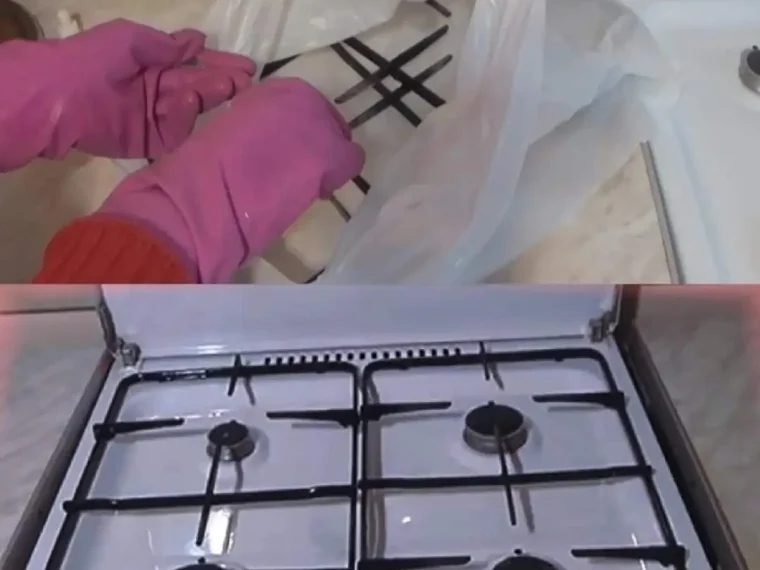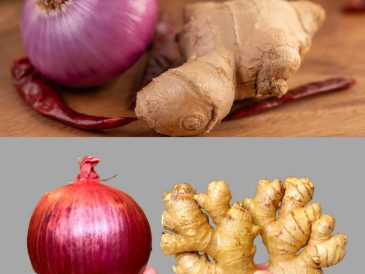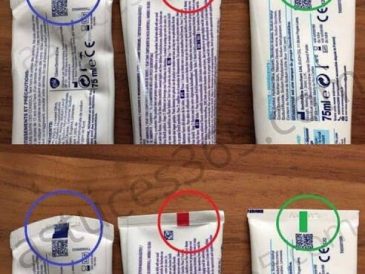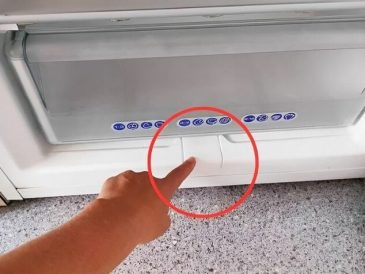Materials You’ll Need:
- Plastic bags (preferably large enough to fit your stove grates easily; multiple grocery bags will do)
- Ammonia (available at most supermarkets or pharmacies)
- Kitchen sponge (for scrubbing)
- Rubber gloves (ammonia can be harsh on the skin, so it’s best to protect your hands)
- Ventilated space (like a well-ventilated kitchen or a garage, as ammonia has a strong smell)
The Process:
- Prepare the Grates:
Remove the stove grates from your stove. If they are coated with a thick layer of burnt-on grease and carbon, don’t worry – you won’t have to scrub it off right away. - Bag the Grates:
Place the grates into a large plastic bag. You can use a thick garbage bag or several of those grocery bags you bring back from the store. Make sure there is enough space for the ammonia to circulate inside the bag. - Add Ammonia:
Pour ammonia directly over the grates. You don’t need to submerge them; a few tablespoons are usually enough because it’s the ammonia vapors that do the heavy lifting. Make sure the ammonia touches most of the surface area of the grates. - Seal the Bag:
Tie the bag shut, ensuring it is tightly sealed. To be safe and avoid any leaks, double or triple bag it. This step is crucial because you want the ammonia vapors to be trapped inside and work on the grime. - Let It Sit Overnight:
Leave the sealed bag in a well-ventilated area, like an outdoor shed or garage. Ammonia has strong fumes, so it’s best not to leave it inside your kitchen overnight if possible. Allow the bag to sit undisturbed for at least 8-12 hours. - The Morning Reveal:
When you open the bag the next morning, you’ll notice that the grime has loosened and is flaking off in pieces. This is because the ammonia vapors have broken down the tough carbon and grease that were baked onto the grates over time. - Final Cleaning:
Remove the grates from the bag, and using a sponge (and some elbow grease), scrub away any remaining residue under running water. You’ll find that the grime comes off easily, leaving your grates sparkling clean. - Rinse Thoroughly:
Make sure to rinse the grates well with water to remove any lingering ammonia residue.
Why Does Ammonia Work So Well?
Ammonia is known for its ability to break down fats, oils, and grease. It’s a potent cleaning agent that’s especially effective on the stubborn carbonized grease found on stove grates. Unlike other methods that involve harsh scrubbing or the use of abrasive tools, ammonia works by releasing vapors that penetrate the grime. This makes it ideal for stove grates, which can have many small crevices where dirt can accumulate.
The real magic happens with ammonia vapors. When sealed in a confined space (like your bag), the vapors attack the grease and carbon deposits, softening them so they can be wiped away with minimal effort.
Safety Precautions When Using Ammonia
- Always work in a ventilated area: Ammonia fumes are strong and can cause respiratory irritation if inhaled in large amounts. Make sure you have good airflow wherever you’re doing this, especially when you open the bag.
- Wear gloves: Ammonia can be harsh on the skin, so wearing rubber gloves will protect your hands.
- Never mix ammonia with other cleaning agents: Especially avoid mixing it with bleach. Combining ammonia with bleach creates a dangerous chemical reaction that produces toxic chlorine gas, which can be harmful to your lungs and eyes.
Other Methods to Clean Stove Grates (If You Don’t Want to Use Ammonia)
For those who may prefer to avoid ammonia or want to try different cleaning approaches, here are some alternative methods that can also help you get those grates looking like new:
1. Baking Soda and Vinegar Paste
Baking soda is a gentle abrasive that works wonders on tough grime.
- Make a thick paste of baking soda and a little bit of water, then spread it over the grates.
- Let it sit for a few hours, then spray it with white vinegar. The fizzing action helps break down the grease and grime.
- Use a sponge to scrub away the residue.
2. Dishwasher Method
For lighter stains, you can simply place the grates in your dishwasher. This won’t work as effectively for extremely greasy or carbonized grates but can help maintain them with regular cleaning.
3. Oven Cleaner
Many stove grates are built to withstand high temperatures, so you can use oven cleaner for a deep clean.
- Spray the grates with the oven cleaner and leave them to sit for a few hours, following the instructions on the label.
- Afterward, rinse and scrub the grates with warm water.
4. Soak in Boiling Water and Dish Soap
For a gentler method, boil a large pot of water and mix in some dish soap. Place your grates in the pot and let them soak for 15-20 minutes. The hot water will help break down grease, while dish soap cuts through the oils. After soaking, scrub with a sponge or steel wool.
Tips for Maintaining Clean Stove Grates
To avoid having to deal with heavily caked-on grease again, here are a few maintenance tips:
- Wipe down the grates regularly after cooking. Even a quick wipe with a damp cloth can prevent grease from building up over time.
- Use a degreaser spray once a week. Products designed for degreasing kitchen surfaces can be applied to stove grates after cooking to keep them clean.
- Use aluminum foil or a stovetop liner to catch spills and drips when cooking. These protective covers can prevent food from splattering onto the grates.
Tackling Other Tough Kitchen Cleaning Tasks
While you’re at it, here are a few more tips for cleaning other hard-to-clean areas in your kitchen:
- Oven Door: Mix baking soda with water to form a paste and apply it to the inside of the oven door. Let it sit for 30 minutes, then wipe off with a damp cloth.
- Microwave: Place a microwave-safe bowl with water and a few tablespoons of vinegar inside the microwave. Heat for 5 minutes, then wipe down the inside.
- Refrigerator Shelves: Remove the shelves and drawers from your refrigerator, soak them in warm, soapy water, and scrub with a sponge.
Conclusion
Cleaning a dirty stove grate doesn’t have to be a chore when you have the right tools and methods. Using ammonia is one of the easiest and most effective ways to tackle stubborn grime, but there are plenty of alternative methods available if you prefer not to use it. With a little regular maintenance and the occasional deep clean, your stove grates can stay looking brand new without too much effort!
Let us know if you have any other household tips or cleaning hacks that work wonders in your kitchen!




